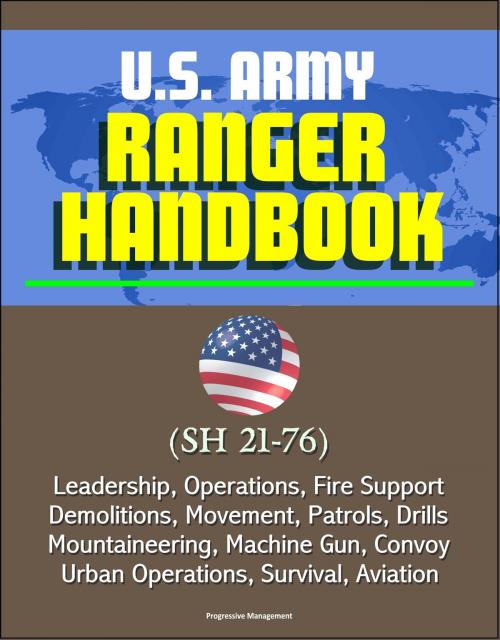U.S. Army Ranger Handbook (SH 21-76) - Leadership, Operations, Fire Support, Demolitions, Movement, Patrols, Drills, Mountaineering, Machine Gun, Convoy, Urban Operations, Survival, Aviation
Nonfiction, History, Military, United States| Author: | Progressive Management | ISBN: | 9781310212550 |
| Publisher: | Progressive Management | Publication: | January 5, 2015 |
| Imprint: | Smashwords Edition | Language: | English |
| Author: | Progressive Management |
| ISBN: | 9781310212550 |
| Publisher: | Progressive Management |
| Publication: | January 5, 2015 |
| Imprint: | Smashwords Edition |
| Language: | English |
The history of the American Ranger is a long and colorful saga of courage, daring, and outstanding leadership. It is a story of men whose skills in the art of fighting have seldom been surpassed. Only the highlights of their numerous exploits are told here. Rangers mainly performed defensive missions until, during King Phillip's War in 1675, Benjamin Church's Company of Independent Rangers (from Plymouth Colony) conducted successful raids on hostile Indians. In 1756, Major Robert Rogers, of New Hampshire, recruited nine companies of American colonists to fight for the British during the French and Indian War. Ranger techniques and methods of operation inherently characterized the American frontiersmen. Major Rogers was the first to capitalize on them and incorporate them into the fighting doctrine of a permanently organized fighting force.
The method of fighting used by the first Rangers was further developed during the Revolutionary War by Colonel Daniel Morgan, who organized a unit known as "Morgan's Riflemen." According to General Burgoyne, Morgan's men were "... .the most famous corps of the Continental Army, all of them crack shots."
Francis Marion, the "Swamp Fox," organized another famous Revolutionary War Ranger element known as "Marion's Partisans." Marion's Partisans, numbering anywhere from a handful to several hundred, operated both with and independent of other elements of General Washington's Army. Operating out of the Carolina swamps, they disrupted British communications and prevented the organization of loyalists to support the British cause, substantially contributing to the American victory. The American Civil War was again the occasion for the creation of special units such as Rangers. John S. Mosby, a master of the prompt and skillful use of cavalry, was one of the most outstanding Confederate Rangers. He believed that by resorting to aggressive action he could compel his enemies to guard a hundred points. He would then attack one of the weakest points and be assured numerical superiority.
CHAPTER 1 - LEADERSHIP * PRINCIPLES * DUTIES, RESPONSIBILITIES, AND ACTIONS * ASSUMPTION OF COMMAND * CHAPTER 2 - OPERATIONS * TROOP-LEADING PROCEDURES * COMBAT INTELLIGENCE * WARNING ORDER * OPERATION ORDER * FRAGMENTARY ORDER * ANNEXES * COORDINATION CHECKLISTS * TASK, PURPOSE, OPERATION * TERRAIN MODEL * CHAPTER 3 - FIRE SUPPORT * BASIC FIRE SUPPORT TASKS, TARGETING, AND INTERDICTION * CAPABILITIES * RISK ESTIMATE DISTANCES * TARGET OVERLAYS * CALL FOR FIRE * CLOSE AIR SUPPORT * CLOSE COMBAT ATTACK AVIATION * CHAPTER 4 - COMMUNICATIONS EQUIPMENT * MILITARY RADIOS * MAN-PACK RADIO ASSEMBLY (AN/PRC-119F) * AUTOMATED NET-CONTROL DEVICE * BASIC TROUBLESHOOTING * ANTENNAS * REPAIRS * CONSTRUCTION AND ADJUSTMENT * FIELD EXPEDIENT (FE) OMNI DIRECTIONAL ANTENNAS * ANTENNA LENGTH PLANNING CONSIDERATIONS * CHAPTER 5 - DEMOLITIONS * INITIATING (PRIMING) SYSTEMS * DETONATION (FIRING) SYSTEMS * SAFETY * EXPEDIENT EXPLOSIVES-IMPROVISED SHAPED CHARGE * EXPEDIENT EXPLOSIVES--PLATTER CHARGE * EXPEDIENT EXPLOSIVES--GRAPESHOT CHARGE * DEMOLITION KNOTS * MINIMUM SAFE DISTANCES * BREACHING CHARGES * TIMBER CUTTING CHARGES * CHAPTER 6 - MOVEMENT * FORMATIONS * MOVEMENT TECHNIQUES * STANDARDS * FUNDAMENTALS * TACTICAL MARCHES * MOVEMENT DURING LIMITED VISIBILITY CONDITIONS * DANGER AREAS * CHAPTER 7 - PATROLS * PRINCIPLES * PLANNING * RECONNAISSANCE * SECURITY * CONTROL * COMMON SENSE * PLANNING * TASK ORGANIZATION * INITIAL PLANNING AND COORDINATION * COMPLETION OF PLAN * RECONNAISSANCE PATROLS * FUNDAMENTALS OF RECONNAISSANCE * TASK STANDARDS * ACTIONS ON THE OBJECTIVE, AREA RECONNAISSANCE * ACTIONS ON THE OBJECTIVE, ZONE RECONNAISSANCE * COMBAT PATROLS * PLANNING CONSIDERATIONS * AMBUSH * HASTY AMBUSH * DELIBERATE (POINT/AREA) AMBUSH * PERFORM RAID * SUPPORTING TASKS * LINKUP * DEBRIEF * OBJECTIVE RALLY POINT * PATROL BASE * MOVEMENT TO CONTACT * TECHNIQUES * TASK STANDARDS
The history of the American Ranger is a long and colorful saga of courage, daring, and outstanding leadership. It is a story of men whose skills in the art of fighting have seldom been surpassed. Only the highlights of their numerous exploits are told here. Rangers mainly performed defensive missions until, during King Phillip's War in 1675, Benjamin Church's Company of Independent Rangers (from Plymouth Colony) conducted successful raids on hostile Indians. In 1756, Major Robert Rogers, of New Hampshire, recruited nine companies of American colonists to fight for the British during the French and Indian War. Ranger techniques and methods of operation inherently characterized the American frontiersmen. Major Rogers was the first to capitalize on them and incorporate them into the fighting doctrine of a permanently organized fighting force.
The method of fighting used by the first Rangers was further developed during the Revolutionary War by Colonel Daniel Morgan, who organized a unit known as "Morgan's Riflemen." According to General Burgoyne, Morgan's men were "... .the most famous corps of the Continental Army, all of them crack shots."
Francis Marion, the "Swamp Fox," organized another famous Revolutionary War Ranger element known as "Marion's Partisans." Marion's Partisans, numbering anywhere from a handful to several hundred, operated both with and independent of other elements of General Washington's Army. Operating out of the Carolina swamps, they disrupted British communications and prevented the organization of loyalists to support the British cause, substantially contributing to the American victory. The American Civil War was again the occasion for the creation of special units such as Rangers. John S. Mosby, a master of the prompt and skillful use of cavalry, was one of the most outstanding Confederate Rangers. He believed that by resorting to aggressive action he could compel his enemies to guard a hundred points. He would then attack one of the weakest points and be assured numerical superiority.
CHAPTER 1 - LEADERSHIP * PRINCIPLES * DUTIES, RESPONSIBILITIES, AND ACTIONS * ASSUMPTION OF COMMAND * CHAPTER 2 - OPERATIONS * TROOP-LEADING PROCEDURES * COMBAT INTELLIGENCE * WARNING ORDER * OPERATION ORDER * FRAGMENTARY ORDER * ANNEXES * COORDINATION CHECKLISTS * TASK, PURPOSE, OPERATION * TERRAIN MODEL * CHAPTER 3 - FIRE SUPPORT * BASIC FIRE SUPPORT TASKS, TARGETING, AND INTERDICTION * CAPABILITIES * RISK ESTIMATE DISTANCES * TARGET OVERLAYS * CALL FOR FIRE * CLOSE AIR SUPPORT * CLOSE COMBAT ATTACK AVIATION * CHAPTER 4 - COMMUNICATIONS EQUIPMENT * MILITARY RADIOS * MAN-PACK RADIO ASSEMBLY (AN/PRC-119F) * AUTOMATED NET-CONTROL DEVICE * BASIC TROUBLESHOOTING * ANTENNAS * REPAIRS * CONSTRUCTION AND ADJUSTMENT * FIELD EXPEDIENT (FE) OMNI DIRECTIONAL ANTENNAS * ANTENNA LENGTH PLANNING CONSIDERATIONS * CHAPTER 5 - DEMOLITIONS * INITIATING (PRIMING) SYSTEMS * DETONATION (FIRING) SYSTEMS * SAFETY * EXPEDIENT EXPLOSIVES-IMPROVISED SHAPED CHARGE * EXPEDIENT EXPLOSIVES--PLATTER CHARGE * EXPEDIENT EXPLOSIVES--GRAPESHOT CHARGE * DEMOLITION KNOTS * MINIMUM SAFE DISTANCES * BREACHING CHARGES * TIMBER CUTTING CHARGES * CHAPTER 6 - MOVEMENT * FORMATIONS * MOVEMENT TECHNIQUES * STANDARDS * FUNDAMENTALS * TACTICAL MARCHES * MOVEMENT DURING LIMITED VISIBILITY CONDITIONS * DANGER AREAS * CHAPTER 7 - PATROLS * PRINCIPLES * PLANNING * RECONNAISSANCE * SECURITY * CONTROL * COMMON SENSE * PLANNING * TASK ORGANIZATION * INITIAL PLANNING AND COORDINATION * COMPLETION OF PLAN * RECONNAISSANCE PATROLS * FUNDAMENTALS OF RECONNAISSANCE * TASK STANDARDS * ACTIONS ON THE OBJECTIVE, AREA RECONNAISSANCE * ACTIONS ON THE OBJECTIVE, ZONE RECONNAISSANCE * COMBAT PATROLS * PLANNING CONSIDERATIONS * AMBUSH * HASTY AMBUSH * DELIBERATE (POINT/AREA) AMBUSH * PERFORM RAID * SUPPORTING TASKS * LINKUP * DEBRIEF * OBJECTIVE RALLY POINT * PATROL BASE * MOVEMENT TO CONTACT * TECHNIQUES * TASK STANDARDS















